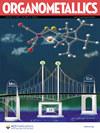Alternative Si–F Elimination and Fluoride Abstraction Pathways in Selective Monodefluorination of Me3SiCF3 and Me3SiCF2H
IF 2.9
3区 化学
Q2 CHEMISTRY, INORGANIC & NUCLEAR
引用次数: 0
Abstract
The silyl reagents Me3SiCF3 (Ruppert–Prakash reagent) and Me3SiCF2H are commonly activated via desilylation to install CF3 and CF2H groups. We explore the C–F activation of these reagents using phosphine and pyridine Lewis bases in combination with boron and/or silicon based Lewis acids to give products of the form [Me3SiCFR(LB)][NTf2] or [HCFR(LB)][NTf2] (R = F or H; LB = P(o-Tol)3, PPh3, PPh2(C6F5), 2,4,6-Ph3-NC5H2). The reaction mechanism is investigated, and we find that it is likely that Me3SiCF3 decomposes to Me3SiF and difluorocarbene, the latter of which reacts with the LB to form a difluoromethylide that reacts with Me3SiNTf2 or adventitious protons. However, Me3SiCF2H undergoes fluoride abstraction and transfer of the [Me3SiCFH]+ fragment to the LB, in a mechanism reminiscent of frustrated Lewis pair activation of fluoroalkanes. The C–F activated silyldifluoromethyl phosphonium salts are shown to facilitate further derivatization through the silyl and phosphino motifs, while the difluoromethylpyridinium salt is shown to be a latent source of difluoromethyl in nucleophilic transfer and redox alkylation reactions.

Me3SiCF3 和 Me3SiCF2H 选择性单脱氟作用中的替代性 Si-F 消除和氟化物萃取途径
硅烷基试剂 Me3SiCF3(Ruppert-Prakash 试剂)和 Me3SiCF2H 通常通过脱碱活化,以安装 CF3 和 CF2H 基团。我们探讨了使用膦和吡啶路易斯碱以及硼和/或硅基路易斯酸对这些试剂进行 C-F 活化,从而得到 [Me3SiCFR(LB)][NTf2] 或 [HCFR(LB)][NTf2] 形式的产物(R = F 或 H;LB = P(o-Tol)3、PPh3、PPh2(C6F5)、2,4,6-Ph3-NC5H2)。通过对反应机理的研究,我们发现 Me3SiCF3 很可能分解成 Me3SiF 和二氟羰基,后者与枸橼酸反应生成二氟甲基,再与 Me3SiNTf2 或外来质子反应。然而,Me3SiCF2H 会发生氟化物抽取,并将 [Me3SiCFH]+ 片段转移到枸橼酸中,其机理与氟烷烃的受挫路易斯对活化相似。C-F 活化的硅烷基二氟甲基鏻盐可通过硅烷基和膦基进一步衍生,而二氟甲基吡啶鎓盐则是亲核转移和氧化还原烷基化反应中二氟甲基的潜在来源。
本文章由计算机程序翻译,如有差异,请以英文原文为准。
求助全文
约1分钟内获得全文
求助全文
来源期刊

Organometallics
化学-无机化学与核化学
CiteScore
5.60
自引率
7.10%
发文量
382
审稿时长
1.7 months
期刊介绍:
Organometallics is the flagship journal of organometallic chemistry and records progress in one of the most active fields of science, bridging organic and inorganic chemistry. The journal publishes Articles, Communications, Reviews, and Tutorials (instructional overviews) that depict research on the synthesis, structure, bonding, chemical reactivity, and reaction mechanisms for a variety of applications, including catalyst design and catalytic processes; main-group, transition-metal, and lanthanide and actinide metal chemistry; synthetic aspects of polymer science and materials science; and bioorganometallic chemistry.
 求助内容:
求助内容: 应助结果提醒方式:
应助结果提醒方式:


